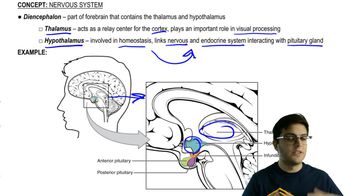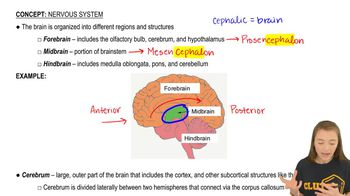Compare and contrast the somatic nervous system and autonomic nervous system.
Alzheimer's disease is a common form of dementia affecting millions of people, especially the elderly. Two regions of the brain are particularly affected, often shrinking dramatically and accumulating large deposits of extracellular material. Based on your knowledge of memory, what two brain regions do you think these are? Explain.

Verified Solution
Key Concepts
Hippocampus

Cerebral Cortex

Extracellular Deposits

Why is memory thought to involve changes in particular synapses? a. At some synapses, more neurotransmitters are released after learning takes place. b. At some synapses, a different type of neurotransmitter is released after learning takes place. c. When researchers stimulated certain neurons electrically, individuals replayed memories. d. When researchers changed synapses in the brains of patients during surgery, the patients' memories changed.
Explain why drugs that prevent neurotransmitters from being taken back up by a presynaptic neuron have dramatic effects on the activity of postsynaptic neurons.
Certain species of frogs in the genus Phyllobates have a powerful defensive adaptation—their skin can secrete a milky fluid that contains an extremely toxic compound called batrachotoxin (BTX). These frogs, which are found in Colombia, are known as poison dart frogs because some indigenous Colombian hunters coat the tips of their blowgun darts with the frogs' skin secretions. An animal hit by one of these darts dies quickly. What is the mechanism of action of BTX? The graph here shows the effect of BTX on the membrane potential of a squid giant axon. Which of the following is the most likely explanation for the effect of BTX on the squid giant axon? a. inactivation of Na+/K+-ATPase b. closing of sodium channels c. opening of sodium channels d. opening of potassium channels
Certain species of frogs in the genus Phyllobates have a powerful defensive adaptation—their skin can secrete a milky fluid that contains an extremely toxic compound called batrachotoxin (BTX). These frogs, which are found in Colombia, are known as poison dart frogs because some indigenous Colombian hunters coat the tips of their blowgun darts with the frogs' skin secretions. An animal hit by one of these darts dies quickly. What is the mechanism of action of BTX? Identify a research technique that could be used to discover how BTX affects specific membrane proteins. Based on the graph in Question 11, what would you expect this technique to show?
Certain species of frogs in the genus Phyllobates have a powerful defensive adaptation—their skin can secrete a milky fluid that contains an extremely toxic compound called batrachotoxin (BTX). These frogs, which are found in Colombia, are known as poison dart frogs because some indigenous Colombian hunters coat the tips of their blowgun darts with the frogs' skin secretions. An animal hit by one of these darts dies quickly. What is the mechanism of action of BTX? As the graph in Question 11 shows, BTX depolarizes the membrane and prevents repolarization. What effect would this have on electrical signaling by the nervous system?
